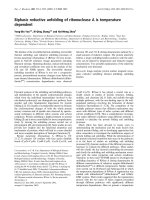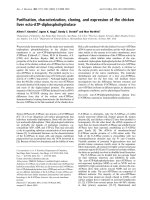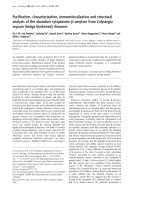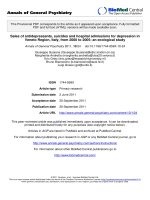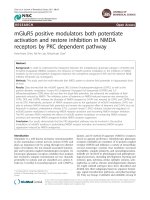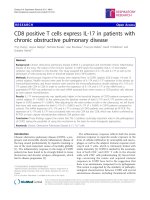Báo cáo y học: "Biphasic positive airway pressure and airway pressure release ventilation Christian Putensen1 and Hermann Wrigge2 for Anesthesiology and Intensive Care Medicine, Department of Anaesthesiology and Intensive Care" docx
Bạn đang xem bản rút gọn của tài liệu. Xem và tải ngay bản đầy đủ của tài liệu tại đây (630.82 KB, 6 trang )
492
APRV = airway pressure release ventilation; ARDS = acute respiratory distress syndrome; ATC = automatic tube compensation; BiPAP = biphasic
positive airway pressure; CMV = controlled mechanical ventilation; CPAP = continuous positive airway pressure; CT = computed tomography; DO
2
=
oxygen delivery; IMV = intermittent mandatory ventilation; PSV = pressure support ventilation; V
A
/Q = ventilation/perfusion; V
T
= tidal volume.
Critical Care December 2004 Vol 8 No 6 Putensen and Wrigge
Introduction
Partial ventilatory support is commonly used, not only to wean
patients from mechanical ventilation but also to provide stable
ventilatory assistance to a desired degree. Conventional
partial ventilatory support modalities either provide ventilatory
assistance to every inspiratory effort and modulate the tidal
volume (V
T
) of the patient (e.g. pressure support ventilation
[PSV] [1] and pressure assisted ventilation [2]) or modulate
minute ventilation by periodically adding mechanical
insufflations to unsupported spontaneous breathing (e.g.
intermittent mandatory ventilation [IMV] [3]). In contrast,
biphasic positive airway pressure (BiPAP) [4] and airway
pressure release ventilation (APRV) [5] allow unrestricted
spontaneous breathing in any phase of the mechanical cycle.
The principles of airway pressure release
ventilation and biphasic positive airway
pressure
APRV and BiPAP ventilate by time-cycled switching between
two pressure levels in a high flow or demand valve
continuous positive airway pressure (CPAP) circuit, and
therefore they allow unrestricted spontaneous breathing in
any phase of the mechanical ventilator cycle [4,5]. The
degree of ventilatory support is determined by the duration of
Review
Clinical review: Biphasic positive airway pressure and airway
pressure release ventilation
Christian Putensen
1
and Hermann Wrigge
2
1
Professor for Anesthesiology and Intensive Care Medicine, Department of Anaesthesiology and Intensive Care Medicine, University of Bonn, Bonn,
Germany
2
Assistant Professor for Anesthesiology and Intensive Care Medicine, Department of Anaesthesiology and Intensive Care Medicine, University of Bonn,
Bonn, Germany
Corresponding author: Christian Putensen,
Published online: 2 August 2004 Critical Care 2004, 8:492-497 (DOI 10.1186/cc2919)
This article is online at />© 2004 BioMed Central Ltd
Abstract
This review focuses on mechanical ventilation strategies that allow unsupported spontaneous
breathing activity in any phase of the ventilatory cycle. By allowing patients with the acute respiratory
distress syndrome to breathe spontaneously, one can expect improvements in gas exchange and
systemic blood flow, based on findings from both experimental and clinical trials. In addition, by
increasing end-expiratory lung volume, as occurs when using biphasic positive airway pressure or
airway pressure release ventilation, recruitment of collapsed or consolidated lung is likely to occur,
especially in juxtadiaphragmatic lung legions. Traditional approaches to mechanical ventilatory
support of patients with acute respiratory distress syndrome require adaptation of the patient to the
mechanical ventilator using heavy sedation and even muscle relaxation. Recent investigations have
questioned the utility of sedation, muscle paralysis and mechanical control of ventilation. Furthermore,
evidence exists that lowering sedation levels will decrease the duration of mechanical ventilatory
support, length of stay in the intensive care unit, and overall costs of hospitalization. Based on
currently available data, we suggest considering the use of techniques of mechanical ventilatory
support that maintain, rather than suppress, spontaneous ventilatory effort, especially in patients with
severe pulmonary dysfunction.
Keywords acute respiratory distress syndrome, airway pressure release ventilation, biphasic positive airway
pressure, mechanical ventilation
493
Available online />both CPAP levels and V
T
during APRV/BiPAP [4,5]. V
T
depends mainly on respiratory compliance and the difference
between the CPAP levels. BiPAP is identical to APRV except
that no restrictions are imposed on the duration of the low
CPAP level (release pressure) [5]. Based on the initial
description, APRV uses a duration of low CPAP (release
time) that is equal to or less than 1.5 s.
Asynchronous interference between spontaneous and
mechanical ventilation may increase the work of breathing
and reduce effective ventilatory support during APRV/BiPAP
[6]. Synchronization of switching between the two CPAP
levels to spontaneous inspiration or expiration has been
incorporated into commercially available demand valve
APRV/BiPAP circuits in order to avoid asynchronous inter-
ference between spontaneous and mechanical breaths.
Because patient triggered mechanical cycles during IMV
have not been demonstrated to be advantageous for the
patient, there is no reason why this should be different for
APRV/BiPAP [6]. When spontaneous breathing is absent,
APRV/BiPAP is not different from conventional pressure
controlled, time cycled mechanical ventilation (PCV) [4,5].
Commercially available ventilators frequently offer combina-
tions of APRV/BiPAP with PSV or automatic tube compensa-
tion (ATC). Only the combination of APRV/BiPAP with ATC
in order to compensate for the resistance of the endotracheal
tube, at least partly, has been shown to confer benefit in
treatment of selected patients [7]. However, the observed
decrease in inspiratory muscle load was associated with
higher pressure support levels when adding ATC during
APRV/BiPAP. In contrast, it remains doubtful whether the
positive effects of different modalities of ventilation are
additive when they are simply combined [8]. Thus, it cannot
be ruled out that proven physiological effects of unassisted
spontaneous breathing during APRV/BiPAP may be
attenuated or even eliminated when each detected
spontaneous breathing effort is assisted with PSV during
APRV/BiPAP.
Setting ventilation pressures and tidal
volumes during airway pressure release
ventilation/biphasic positive airway pressure
Mechanical ventilation with positive end-expiratory airway
pressure titrated above the lower inflection pressure of a
static pressure–volume curve and low V
T
has been
suggested to prevent tidal alveolar collapse at end-expiration
and overdistension of lung units at end-inspiration during
acute respiratory distress syndrome (ARDS) [9]. This lung
protective ventilatory strategy has been found to improve lung
compliance, venous admixture, and arterial oxygen tension
without causing cardiovascular impairment in ARDS [9].
Mechanical ventilation using a V
T
of not more than 6 ml/kg
ideal body weight has been shown to improve outcome in
patients with ARDS [9,10]. Based on these results, CPAP
levels during APRV/BiPAP should be titrated to prevent end-
expiratory alveolar collapse and tidal alveolar overdistension
[9,10]. When CPAP levels during APRV/BiPAP were
adjusted according to a lung protective ventilatory strategy,
the occurrence of spontaneous breathing improved
cardiorespiratory function without affecting total oxygen
consumption because of the work of breathing in patients
with ARDS [11].
Moreover, pulmonary compliance in this range of airway
pressures should be greatest, thus reducing the
transpulmonary pressure required for normal tidal breathing
and hence reducing the elastic work of breathing [12].
Because APRV and BiPAP do not provide ventilatory
assistance to every inspiratory effort, the use of proper CPAP
levels is required to allow efficient ventilation with minimal
work of breathing during unsupported spontaneous breaths.
Analgesia and sedation during airway
pressure release ventilation/biphasic positive
airway pressure
Apart from ensuring sufficient pain relief and anxiolysis,
analgesia and sedation are used to adapt the patient to
mechanical ventilation [13,14]. The level of analgesia and
sedation required during controlled mechanical ventilation
(CMV) is equivalent to a Ramsay score of between 4 and 5
(i.e. a deeply sedated patient who is unable to respond when
spoken to and has no sensation of pain). During partial
ventilatory support a Ramsay score between 2 and 3 can be
targeted (i.e. an awake, responsive and cooperative patient).
In a study conducted in about 600 post-cardiac-surgery
patients [15] and in another study of patients with multiple
injuries [16], maintaining spontaneous breathing with
APRV/BiPAP led to significantly lower consumption of
analgesics and sedatives as compared with the initial use of
CMV followed by weaning with partial ventilatory support.
Clearly, the higher doses of analgesics and sedatives used
exclusively to adapt patients to CMV required higher doses of
vasopressors and positive inotropes to maintain stability of
cardiovascular function [16].
Benefits of maintained spontaneous
breathing during airway pressure release
ventilation/biphasic positive airway pressure
Pulmonary gas exchange
Computed tomography (CT) of patients with ARDS has been
used to identify radiographic densities corresponding to
alveolar collapse that is localized primarily in the dependent
lung regions, correlating with intrapulmonary shunting [17].
Formation of radiographic densities has been attributed to
alveolar collapse caused by superimposed pressure on the
lung and a cephalad shift of the diaphragm that is most
evident in dependent lung areas during mechanical ventilation
[18]. Persisting spontaneous breathing has been considered
to improve the distribution of ventilation to dependent lung
areas and thereby ventilation/perfusion (V
A
/Q) matching,
presumably by diaphragmatic contraction opposing alveolar
494
Critical Care December 2004 Vol 8 No 6 Putensen and Wrigge
compression [11,19]. This concept is supported by CT
observations in anaesthetized patients demonstrating that
contractions in the diaphragm induced by phrenic nerve
stimulation favour distribution of ventilation to dependent, well
perfused lung areas and decrease atelectasis formation [20].
Spontaneous breathing with APRV/BiPAP in experimentally
induced lung injury was associated with less atelectasis
formation in end-expiratory spiral CT of the whole lungs and
in scans above the diaphragm (Fig. 1) [21]. Although other
inspiratory muscles may also contribute to improvement in
aeration during spontaneous breathing, the craniocaudal
gradient in aeration, aeration differences, and the marked
differences in aeration in regions close to the diaphragm
between APRV/BiPAP with and without spontaneous
breathing suggest a predominant role played by diaphrag-
matic contractions in the observed aeration differences [21].
These experimental findings are supported by observations
using electro-impedance tomography to estimate regional
ventilation in patients with ARDS, which demonstrated better
ventilation in dependent regions during spontaneous
breathing with APRV/BiPAP (Fig. 2). Experimental data suggest
that recruitment of dependent lung areas may be caused
essentially by an increase in transpulmonary pressure due to
the decrease in pleural pressure with spontaneous breathing
during APRV/BiPAP [22].
In patients with ARDS, APRV/BiPAP with spontaneous
breathing of 10–30% of the total minute ventilation accounted
for an improvement in V
A
/Q matching and arterial oxygenation
Figure 1
Computed tomography of a lung region above the diaphragm in a pig with oleic acid induced lung injury during airway pressure release
ventilation/biphasic positive airway pressure (a) with and (b) without spontaneous breathing while maintaining airway pressure limits equal.
Figure 2
Electro-impedance tomography used to estimate regional ventilation in patients with acute respiratory distress syndrome during continuous positive
airway pressure (CPAP) and airway pressure release ventilation (APRV)/biphasic positive airway pressure (BiPAP) with and without spontaneous
breathing. Spontaneous breathing with CPAP is associated with better ventilation in the dependent well perfused lung regions. Spontaneous
breathing with APRV/BiPAP is associated with better ventilation in the dependent well perfused lung regions and the anterior lung areas. When
spontaneous breathing during APRV/BiPAP is abolished, mechanical ventilation is directed entirely to the less well perfused, nondependent
anterior lung areas. PCV, pressure-controlled ventilation.
495
(Fig. 3) [11]. Increase in arterial oxygenation in conjunction
with greater pulmonary compliance indicates recruitment of
previously nonventilated lung areas. Clinical studies in
patients with ARDS show that spontaneous breathing during
APRV/BiPAP does not necessarily lead to instant
improvement in gas exchange, but rather to a continuous
improvement in oxygenation over 24 hours after the start of
spontaneous breathing [23].
Assisted inspiration with PSV did not produce significant
improvement in intrapulmonary shunt, V
A
/Q matching, or gas
exchange when compared with CMV in a previous study [11].
This is in agreement with observations demonstrating
comparable gas exchange in patients with acute lung injury
during CMV and PSV [24]. Apparently, spontaneous
contribution on a mechanically assisted breath was not
sufficient to counteract V
A
/Q maldistribution of positive
pressure lung insufflations. One possible explanation might
be that inspiration is terminated by the decrease in gas flow
at the end of inspiration during PSV [1], which may reduce
ventilation in areas of the lung with a slow time constant.
In patients at risk for developing ARDS, maintained
spontaneous breathing with APRV/BiPAP resulted in lower
venous admixture and better arterial blood oxygenation over
an observation period of more than 10 days as compared
with CMV with subsequent weaning [16]. These findings
show that, even in patients requiring ventilatory support,
maintained spontaneous breathing can counteract
progressive deterioration in pulmonary gas exchange.
Cardiovascular effects
Positive pressure ventilation increases intrathoracic pressure,
which in turn reduces venous return to the heart [25]. In
normovolaemic and hypovolaemic patients, this produces
reduction in right and left ventricular filling and results in
decreased stroke volume, cardiac output and oxygen delivery
(D
O
2
). Reducing mechanical ventilation to a level that
provides adequate support for existing spontaneous
breathing should help to reduce the cardiovascular side
effects of ventilatory support [26]. This concept is supported
by studies of anaesthetized animals with haemorrhagic shock,
which demonstrated that contractions of the diaphragm
induced by phrenic nerve stimulation favour preload and
cardiac output [27].
A transient decrease in intrathoracic pressure resulting from
maintained spontaneous breathing of 10–40% of total minute
ventilation during APRV/BiPAP promotes venous return to
the heart and right and left ventricular filling, thereby
increasing cardiac output and D
O
2
[11]. Simultaneous
elevations in right ventricular end-diastolic volume and
cardiac index occurred during spontaneous breathing with
APRV/BiPAP, which indicates improved venous return to the
heart [11]. In addition, outflow from the right ventricle, which
depends mainly on lung volume, may benefit from a decrease
in intrathoracic pressure during APRV/BiPAP. Ventilatory
support of each individual inspiration with PSV at identical
airway pressures produces no or a small increase in cardiac
index [11]. The increase in cardiac index observed during
PSV as compared with CMV was primarily a function of the
pressure support level. This indicates that during assisted
inspiration with PSV spontaneous respiratory activity may not
decrease intrathoracic pressures sufficiently to counteract
the cardiovascular depression of positive airway pressure.
Räsänen and coworkers [28] observed no decrease in cardiac
output and tissue D
O
2
by switching from CPAP to spontaneous
breathing with APRV/BiPAP. In contrast, similar ventilatory
support with CMV reduced the stroke volume and D
O
2
.
Theoretically, augmentation of the venous return to the heart
and increased left ventricular afterload as a result of an
intermittent decrease in intrathoracic pressure during
APRV/BiPAP should have a negative impact on cardio-
vascular function in patients with left ventricular dysfunction.
Provided that spontaneous breathing receives adequate
support and sufficient CPAP levels are applied, maintenance
of spontaneous breathing during APRV/BiPAP should not
prove disadvantageous and is not per se contraindicated in
patients with ventricular dysfunction [29–31].
Oxygen supply and demand balance
The concomitant increase in cardiac index and arterial oxygen
tension during APRV/BiPAP improved the relationship
between tissue oxygen supply and demand because oxygen
consumption remained unchanged despite the work of
spontaneous breathing (Fig. 4). In accordance with previous
Available online />Figure 3
Spontaneous breathing during airway pressure release ventilation
(APRV)/biphasic positive airway pressure (BiPAP) accounted for a
decrease in blood flow to shunt units (ventilation/perfusion
[V
A
/Q] < 0.005) and an increase in perfusion of normal V
A
/Q units
(0.1 < V
A
/Q < 10), without creating low V
A
/Q areas (0.05 < V
A
/Q < 0.1).
Pressure support ventilation had no effect on pulmonary blood flow
distribution when compared with controlled mechanical ventilation
(APRV/BiPAP without spontaneous breathing).
496
experimental [32] and clinical findings [11,33], total oxygen
consumption is not measurably altered by adequately
supported spontaneous breathing in patients with low lung
compliance during APRV/BiPAP.
Organ perfusion
By reducing cardiac index and venous return to the heart,
mechanical ventilation can have a negative effect on the
perfusion and functioning of extrathoracic organ systems.
Increase in venous return and cardiac index, caused by the
periodic fall in intrathoracic pressure during spontaneous
inspiration, should significantly improve organ perfusion and
function during partial ventilatory support. In patients with
ARDS, spontaneous breathing with IMV leads to an increase
in glomerular filtration rate and sodium excretion [34]. This
has also been documented during spontaneous breathing
with APRV/BiPAP [35] (Fig. 5). Thus, maintained
spontaneous breathing may be favourable with respect to the
perfusion and function of the kidney in patients requiring
ventilatory support because of severe pulmonary dysfunction.
Preliminary data in patients requiring ventilatory support for
acute lung injury suggest that maintained spontaneous
breathing may be beneficial for liver function. These clinical data
are supported by experiments in which coloured microspheres
were used in pigs with oleic acid induced lung injury [36];
improved perfusion of the splanchnic area was demonstrated.
Conclusion
Development in mechanical ventilatory support has produced
techniques that allow unrestricted breathing throughout
mechanical ventilation. Investigations demonstrate that
uncoupling of even minimal spontaneous and mechanical
breaths during BiPAP/APRV contributes to improved
pulmonary gas exchange, systemic blood flow and oxygen
supply to the tissue. This is reflected by clinical improvement
in the patient’s condition, which is associated with
significantly fewer days on ventilatory support, earlier
extubation and a shorter stay in the intensive care unit [16].
Competing interests
The author(s) declare that they have no competing interests.
References
1. Hansen J, Wendt M, Lawin P: A new weaning procedure (inspi-
ratory flow assistance). Anaesthesist 1984, 33:428-432.
2. Younes M: Proportional assist ventilation, a new approach to
ventilatory support. Theory. Am Rev Respir Dis 1992, 145:114-
120.
3. Downs JB, Klein EF Jr, Desautels D, Modell JH, Kirby RR: Inter-
mittent mandatory ventilation: a new approach to weaning
patients from mechanical ventilators. Chest 1973, 64:331-335.
4. Baum M, Benzer H, Putensen C, Koller W: Biphasic positive
airway pressure (BIPAP): a new form of augmented ventila-
tion. Anaesthesist 1989, 38:452-458.
5. Stock MC, Downs JB: Airway pressure release ventilation. Crit
Care Med 1987, 15:462-466.
6. Putensen C, Leon MA, Putensen-Himmer G: Timing of pressure
release affects power of breathing and minute ventilation
during airway pressure release ventilation. Crit Care Med
1994, 22:872-878.
7. Wrigge H, Zinserling J, Hering R, Schwalfenberg N, Stuber F, von
Spiegel T, Schroeder S, Hedenstierna G, Putensen C: Car-
diorespiratory effects of automatic tube compensation during
airway pressure release ventilation in patients with acute lung
injury. Anesthesiology 2001, 95:382-389.
8. Räsänen J: IMPRV: synchronized APRV, or more? Intensive
Care Med 1992, 18:65-66.
9. Amato MB, Barbas CS, Medeiros DM, Magaldi RB, Schettino GP,
Lorenzi-Filho G, Kairalla RA, Deheinzelin D, Munoz C, Oliveira R,
et al.: Effect of a protective-ventilation strategy on mortality in
the acute respiratory distress syndrome. N Engl J Med 1998,
338:347-354.
Critical Care December 2004 Vol 8 No 6 Putensen and Wrigge
Figure 4
Oxygen consumption plotted against oxygen delivery during airway
pressure release ventilation (APRV)/biphasic positive airway pressure
(BiPAP) with and without spontaneous breathing and during
inspiratory assistance with pressure support ventilation (PSV). Oxygen
consumption was determined by indirect calorimetry. Bars indicate
standard deviation.
Figure 5
Urine volume (Uvol), effective renal plasma flow (ERPF) and glomerular
filtration rate (GFR) during airway pressure release ventilation (APRV)
with and without spontaneous breathing (SB). During APRV without
SB, airway pressure was adjusted to produce equal minute ventilation
(V
E
; normocapnia) while APRV without spontaneous breathing was
administered with equal airway pressure limits (P
aw
; permissive
hypercapnia). Vertical bars indicate standard deviation.
497
Available online />10. ARDS network: Ventilation with lower tidal volumes as com-
pared with traditional tidal volumes for acute lung injury and
the acute respiratory distress syndrome. The Acute Respira-
tory Distress Syndrome Network. N Engl J Med 2000, 342:
1301-1308.
11. Putensen C, Mutz NJ, Putensen-Himmer G, Zinserling J: Sponta-
neous breathing during ventilatory support improves ventila-
tion–perfusion distributions in patients with acute respiratory
distress syndrome. Am J Respir Crit Care Med 1999, 159:
1241-1248.
12. Katz JA, Marks JD: Inspiratory work with and without continu-
ous positive airway pressure in patients with acute respiratory
failure. Anesthesiology 1985, 63:598-607.
13. Wheeler AP: Sedation, analgesia, and paralysis in the inten-
sive care unit. Chest 1993, 104:566-577.
14. Burchardi H, Rathgeber J, Sydow M: The concept of analgo-
sedation depends on the concept of mechanical ventilation. In
Yearbook of Intensive Care and Emergency Medicine. Edited by
Vincent JL. Berlin, Heidelberg, New York: Springer-Verlag;
1995:155-164.
15. Rathgeber J, Schorn B, Falk V, Kazmaier S, Spiegel T: The influ-
ence of controlled mandatory ventilation (CMV), intermittent
mandatory ventilation (IMV) and biphasic intermittent positive
airway pressure (BIPAP) on duration of intubation and con-
sumption of analgesics and sedatives. A prospective analysis
in 596 patients following adult cardiac surgery. Eur J Anaes-
thesiol 1997, 14:576-582.
16. Putensen C, Zech S, Wrigge H, Zinserling J, Stüber F, von
Spiegel T, Mutz N: Long-term effects of spontaneous breath-
ing during ventilatory support in patients with acute lung
injury. Am J Respir Crit Care Med 2001, 164:43-49.
17. Gattinoni L, Presenti A, Torresin A, Baglioni S, Rivolta M, Rossi F,
Scarani F, Marcolin R, Cappelletti G: Adult respiratory distress
syndrome profiles by.computed tomography. J Thorac Imaging
1986, 1:25-30.
18. Puybasset L, Cluzel P, Chao N, Slutsky AS, Coriat P, Rouby JJ: A
computed tomography scan assessment of regional lung
volume in acute lung injury. The CT Scan ARDS Study Group.
Am J Respir Crit Care Med 1998, 158:1644-1655.
19. Froese AB, Bryan AC: Effects of anesthesia and paralysis on
diaphragmatic mechanics in man. Anesthesiology 1974, 41:
242-255.
20. Hedenstierna G, Tokics L, Lundquist H, Andersson T, Strandberg
A: Phrenic nerve stimulation during halothane anesthesia.
Effects of atelectasis. Anesthesiology 1994, 80:751-760.
21. Wrigge H, Zinserling J, Neumann P, Defosse J, Magnusson A,
Putensen C, Hedenstierna G: Spontaneous breathing improves
lung aeration in oleic acid-induced lung injury. Anesthesiology
2003, 99:376-384.
22. Henzler D, Dembinski R, Bensberg R, Hochhausen N, Rossaint R,
Kuhlen R: Ventilation with biphasic positive airway pressure in
experimental lung injury: influence of transpulmonary pres-
sure on gas exchange and haemodynamics. Intensive Care
Med 2004, 30:935-943.
23. Sydow M, Burchardi H, Ephraim E, Zielmann S: Long-term
effects of two different ventilatory modes on oxygenation in
acute lung injury. Comparison of airway pressure release ven-
tilation and volume-controlled inverse ratio ventilation. Am J
Respir Crit Care Med 1994, 149:1550-1556.
24. Cereda M, Foti G, Marcora B, Gili M, Giacomini M, Sparacino ME,
Pesenti A: Pressure support ventilation in patients with acute
lung injury. Crit Care Med 2000, 28:1269-1275.
25. Pinsky MR: Determinants of pulmonary arterial flow variation
during respiration. J Appl Physiol 1984, 56:1237-1245.
26. Kirby RR, Perry JC, Calderwood HW, Ruiz BC: Cardiorespiratory
effects of high positive.end-expiratory pressure. Anesthesiol-
ogy 1975, 43:533-539.
27. Samniah N, Voelckel WG, Zielinski TM, McKnite S, Patterson R,
Benditt DG, Lurie KG: Feasibility and effects of transcutaneous
phrenic nerve stimulation combined with an inspiratory
impedance threshold in a pig model of hemorrhagic shock.
Crit Care Med 2003, 31:1197-1202.
28. Räsänen J, Downs JB: Cardiovascular effects of conventional
positive.pressure ventilation and airway pressure release ven-
tilation. Chest 1988, 93:911-915.
29. Räsänen J, Heikkila J, Downs J, Nikki P, Vaisanen I, Viitanen A:
Continuous positive airway pressure by face mask in acute
cardiogenic pulmonary edema. Am J Cardiol 1985, 55:296-
300.
30. Nikki P, Tahvanainen J, Räsänen J, Makelainen A: Ventilatory
pattern in respiratory failure arising from acute myocardial
infarction. II. PtcO2 and PtcCO2 compared to Pao2 and
PaCO2 during IMV4 vs IPPV12 and PEEP0 vs PEEP10. Crit
Care Med 1982, 10:79-81.
31. Räsänen J, Nikki P: Respiratory failure arising from acute
myocardial infarction. Ann Chir Gynaecol Suppl 1982, 196:43-
47.
32. Putensen C, Räsänen J, Lopez FA: Effect of interfacing between
spontaneous breathing and mechanical cycles on the ventila-
tion-perfusion distribution in canine lung injury. Anesthesiol-
ogy 1994, 81:921-930.
33. Staudinger T, Kordova H, Roggla M, Tesinsky P, Locker GJ,
Laczika K, Knapp S, Frass M: Comparison of oxygen cost of
breathing with pressure-support ventilation and biphasic
intermittent positive airway pressure ventilation. Crit Care
Med 1998, 26:1518-1522.
34. Steinhoff H, Falke K, Schwarzhoff W: Enhanced renal function
associated with intermittent mandatory ventilation in acute
respiratory failure. Intensive Care Med 1982, 8:69-74.
35. Hering R, Peters D, Zinserling J, Wrigge H, von Spiegel T,
Putensen C: Effects of spontaneous breathing during airway
pressure release ventilation on renal perfusion and function
in patients with acute lung injury. Intensive Care Med 2002, 28:
1426-1433.
36. Hering R, Viehofer A, Zinserling J, Wrigge H, Kreyer S, Berg A,
Minor T, Putensen C: Effects of spontaneous breathing during
airway pressure release ventilation on intestinal blood flow in
experimental lung injury. Anesthesiology 2003, 99:1137-1144.

